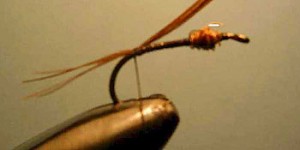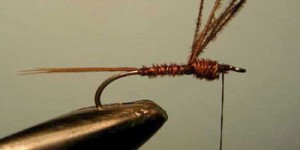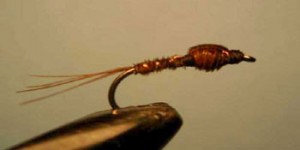Pheasant Tail Nymph
Materials required:
- Round bend down eye hook – Sizes 10 – 16
- Body – Cock pheasant tail fibres
- Tying thread fine black or brown
- Rib – fine copper wire
- Thorax – Fine copper wire
- Wing case – Cock pheasant tail fibres
- Tail – Cock pheasant tail fibres
- Head – build up neat head of tying thread
Tying:
1. Tie in the fine copper wire behind the eye and form a copper wire ball for the thorax. Tie in tying thread behind copper wire ball and take down to bend in touching turns. Tie in a few tips of cock pheasant tail fibres to form tail. (the rest of the fibres are used for the body)

2. Tie in length of fine copper wire. Take tying thread back up to behind the copper wire ball. Wind cock pheasant fibres up body in touching turns to the ball and secure with the thread and leave remainder of fibres on top of hook to form thorax cover. Follow with the copper wire in open turns to form the rib as far as the ball and tie off copper wire. Tie in addition cock pheasant fibres and wind around the copper ball and tie off behind the eye.

3. Take the cock pheasant fibres that are on top of hook and pull over thorax to form cover and tie off behind the eye, form a neat head, tie off and varnish the head.

This nymph does not represent a specific aquatic nymph but is used as a general nymph/bug pattern and is very effective as its features are found on many nymphs. It can also be tied on short or long shank hooks and can even be tied with a lead under belly .
The thorax can also be seals fur of different colours and of course dyed cock pheasant fibres can be used to form a whole series of different pheasant tail nymphs.
This nymph can be used all season in both rivers and lakes and on floating or sinking lines. A good retrieve is a short jerky one and takes can be quite fierce.
